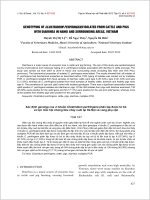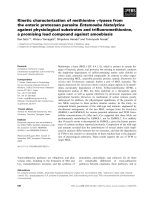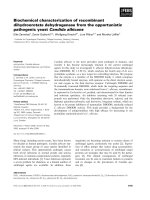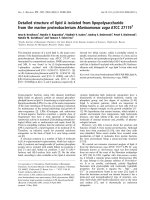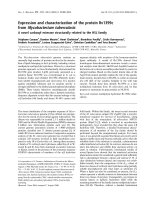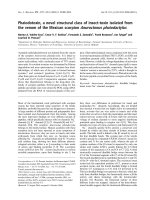Characterization of wild yeasts isolated from selected fruits for their bread leavening capacity
Bạn đang xem bản rút gọn của tài liệu. Xem và tải ngay bản đầy đủ của tài liệu tại đây (1.77 MB, 68 trang )
ADDIS ABABA UNIVERSITY
SCHOOL OF GRADUATE STUDIES
INSTITUTE OF BIOTECHNOLOGY
Characterization of Wild Yeasts Isolated from Selected Fruits for their
Bread Leavening Capacity
BY
Eshet Lakew
A Thesis Submitted to the School of Graduate Studies, Addis Ababa University in Partial
Fulfillment of the Requirement for the Degree of Master of Science in Biotechnology
Addis Ababa, Ethiopia
June, 2017
ADDIS ABABA UNIVERSITY
SCHOOL OF GRADUATE STUDIES
INSTITITUTE OF BIOTECHNOLOGY
This is to certify that the thesis prepared by Eshet Lakew, entitled with: Characterization of Wild
Yeasts Isolated from Selected Fruits for their Bread Leavening Capacity and submitted in
partial fulfilment of the requirement for the Degree of Master of Science in Biotechnology
complies with the regulations of the University and meets the accepted standards with respect to
originality and quality.
Signed by the Examining committee:Dr. Amare Gessesse (Examiner)
signature_____________ Date______________
Dr. Addis Simachew (Examiner)
signature_____________ Date______________
Dr. Diriba Muleta
signature______________Date______________
(Advisor)
Dr. Anteneh Tesfaye (Advisor)
signature____________ Date_______________
Dr. Tesfaye Sisay
signature_____________ Date______________
Director, Institute of Biotechnology
Characterization of Wild Yeasts Isolated from Selected Fruits for their Bread Leavening Capacity
By: Eshet Lakew
Email: or
Addis Ababa University/Institute of Biotechnology, P.O.Box, 1176, Addis Ababa, Ethiopia.
ABSTRACT: Leavening agents are important in raising flour dough. Biological leavening agents are
microorganisms that have the ability to produce carbon dioxide from the utilization of Sugar and thereby
ferment and raise the dough. The present study was carried out to characterize yeast isolates isolated
from selected fruits and to assess their leavening potential of wheat dough under laboratory scale. The
collected fruit samples were processed to isolate yeasts using Potato Dextrose Agar (PDA) amended
with 0.1 g/L chloramphenicol. Initially, 88 yeasts were isolated from the fruits and were first tested for
their carbohydrate fermentation in yeast extract peptone dextrose (YEPD) broth medium. Six yeast
isolates with their sugar fermentative abilities were selected and tested for H2S production. Among them,
AAUGr5, AAUOr7 and AAUPi3 found not produce undesirable H2S for bread baking quality on both
Kligler Iron Agar (KIA) and Bismuth Sulfite Agar (BSA) media. The three yeast isolates were identified
as Saccharomyces using colonial, morphological parameters and biochemical tests. The optimum
growth pH and temperature values for the three selected yeast isolates were recorded as 5 and 30 oC,
respectively, in YEPD medium. In addition, 30% (w/v) D-glucose and 5 %( w/v) NaCl concentrations
showed optimum growth of the three selected yeast isolates in yeast extract peptone broth medium. In
all the cases, the maximum biomass was achieved at 96 hrs of incubation and there was a rapid decrease
in biomass for all the yeast isolates after 96 hrs of incubation. In terms of CO2 and biomass production
as well as leavening potential, starter cultures which were formulated from the combination of the three
yeast isolates (AAUGr5+AAUOr7+AAUPi3)
showed better performance
than starter cultures
formulated from paired combination of the three isolates or each of the three isolates separately.
However, isolate AAUGr5 was found to be satisfactorily potent for leavening action from the single
isolates. The present study could therefore be important with respect to screening of wild yeast isolates
that possess better bread leavening potential for extending the use of indigenous microbes as starter
culture in bakery sector.
Keywords/Phrases: biomass, carbon dioxide, fruits, hydrogen sulphide, laboratory scale leavening,
yeast isolation
i
ACKNOWLEDGEMENTS
I would like to express my sincere gratitude and heartfelt thanks to my research advisors, Dr. Diriba
Muleta and Dr. Anteneh Tesfaye for their invaluable comment, professional guidance and excellent
cooperation during my study period.
I would like to thank Addis Ababa University particularly Institute of Biotechnology and its staff’s for
providing this opportunity that made this study possible, without which my dream would not have come
true.
I am sincerely thankful to Dr. Tesfaye Alemu for allowing me to use the laboratory and his kind
encouragement during my stay in the laboratory.
I am also very grateful to the following PhD candidates, Girma Kebede, Moges Kibret, Tamene
Milkessa, Yonas Chekol, Asmamaw Tesfaw, Alemayehu Getahun, Teshome Geremew and MSc
candidates, Elsa Beyene and Senait Leykun for their inspiring discussion and support.
I would like to acknowledge the Laboratory technicians Zenebech Aytenew and Nigat Mekonnen for
their encouragement and cooperation in materials and technical support.
Thanks also go to all the people I met during the thesis work for their invaluable contributions to my
work, whom I could not name them here due to limited space.
And, of course, thanks to my family.
Above all, my special thanks go to the Almighty God for giving me patience and strength throughout
the study period.
ii
Table of Contents
ABSTRACT ………………………………………………………………………………………i
ACKNOWLEDGEMENTS ......................................................................................................... ii
List of Tables ................................................................................................................................. v
List of Figures............................................................................................................................... vi
1. Introduction ............................................................................................................................... 1
2. Objectives .................................................................................................................................. 4
2.1. General objective.................................................................................................................. 4
2.2. Specific objectives................................................................................................................ 4
3. Literature review ...................................................................................................................... 5
3.1. General characteristics of yeast ............................................................................................ 5
3.1.1. Yeasts and classification ................................................................................................ 5
3.1.2. Genus Saccharomyces ................................................................................................... 5
3.1.3. Reproduction and cell cycle .......................................................................................... 6
3.1.4. Yeast Identification........................................................................................................ 8
3.1.5. Importance of yeast in food fermentation .................................................................... 10
3.2. Nutrition and their growth .................................................................................................. 11
3.3. Yeast Metabolism ............................................................................................................... 15
3.4. Food Grade Yeasts ............................................................................................................. 16
3.5. Characteristics of baker’s yeast fermentation .................................................................... 16
3.6. Formulation methods of bakery yeasts............................................................................... 17
4. Materials and Methods ........................................................................................................... 18
4.1. Sampling site and sample collection .................................................................................. 18
4.1.1. Sample preparation ...................................................................................................... 18
4.1.2. Isolation of yeasts ........................................................................................................ 19
4.2. Cultural characterization .................................................................................................... 19
4.3. Major screening parameters of yeast isolates for bread leavening..................................... 19
iii
4.4. Standard culture and maintenance...................................................................................... 20
4.5. Identification of yeast isolates ............................................................................................ 20
4.5.1. Morphological characterization ................................................................................... 20
4.6. Viability determination of selected yeast isolates .............................................................. 22
4.7. Biochemical characterization ............................................................................................. 22
4.8. Analyzing factors affecting the growth of yeast isolates ................................................... 23
4.9. Determination of agitation and aeration effect ................................................................... 24
4.10. Starter culture formulation of selected yeast isolates ....................................................... 24
4.11. Leavening analysis of selected yeast isolates ................................................................... 25
4.12. Designation of yeast isolates ............................................................................................ 25
4.13. Data analysis .................................................................................................................... 25
5. Results ...................................................................................................................................... 26
5.1. Characterization of yeast isolates ....................................................................................... 26
5.2. Cultural Characterization ................................................................................................... 26
5.3. Production of CO2 .............................................................................................................. 27
5.4. Production of H2S............................................................................................................... 28
5.5. Microscopic observation of selected yeast isolates ............................................................ 29
5.6. Cell count and viability of selected yeast isolates .............................................................. 30
5.7. Biochemical characteristics of selected yeast isolates ....................................................... 30
5.8. Effect of Temperature ........................................................................................................ 31
5.9. Effect of pH ........................................................................................................................ 32
5.10. Effect of D-glucose .......................................................................................................... 32
5.11. Effect of NaCl .................................................................................................................. 33
5.12. Effect of shaking .............................................................................................................. 34
5.13. Leavening Action ............................................................................................................. 35
6. Discussion ................................................................................................................................ 36
7. Conclusion ............................................................................................................................... 39
8. Recommendation .................................................................................................................... 40
References ............................................................................................................................... 41
iv
List of Tables
Table 1 Useful carbon and energy sources for Saccharomyces cerevisiae .................................. 13
Table 2 Assimilation of N2 derivatives by Saccharomyces cerevisiae ........................................ 14
Table 3 The type and number of yeast isolates included in the starter culture formulation ........ 24
Table 4 Cultural or colony characteristics of isolated yeast after 48 hrs of incubation ............... 26
Table 5 Isolates producing more CO2 from each substrate anaerobically .................................... 27
Table 6 Colony counts on PDA.................................................................................................... 30
Table 7 Biochemical characteristics of isolated yeast isolates anaerobically .............................. 31
Table 8 Effect of D-glucose on the growth of yeast isolates aerobically ..................................... 33
Table 9 Effect of NaCl on the growth of yeast isolates aerobically ............................................. 33
Table 10 Comparison of leavening action of yeast isolate from fruits and commercial baker’s
yeast both at room temperature and 30oC at different time. ......................................... 35
v
List of Figures
Fig.1 Life cycle of yeasts ................................................................................................................ 7
Fig.2 Standard yeast growth curve ................................................................................................. 8
Fig.3 Schematic representation of the internal transcribed spacer (ITS) region of ribosomal RNA
(rRNA). .............................................................................................................................. 10
Fig.4 Utilization of carbon by yeast. ............................................................................................ 12
Fig.5. Observation of H2S gas production by cultures on BSA (upper) and KIA media (lower) 28
Fig.6 The cell morphology under compound microscope (OLYMPUS BX51)........................... 29
Fig.7 Effect of temperature on the growth of yeasts in YEPD at 96 hrs of incubation ................ 31
Fig.8 Effect of pH on the growth of yeasts in YEPD at 96 hrs of incubation .............................. 32
Fig.9 Effect of shaking condition on biomass production by the yeast isolates ........................... 34
vi
List of Abbreviations
BSA
hrs
KIA
ml
OD
PDA
rpm
w/v
YEPD
Bismuth sulfite agar
hours
Kligler Iron Agar
Mili liter
Optical Density
Potato Dextrose Agar
Revolution per minute
Weight per volume
Yeast Extract Peptone Dextrose
vii
1. Introduction
Bread is reported to be one of the most ancient human foods that was produced with the help of
microorganisms by an ancient Egyptian bakery at the Giza Pyramid area in the year 4000 B.C
(Willey et al., 2008). Saccharomyces cerevisiae is the most commonly used species in the genus
Saccharomyces for bread baking. It has been employed as baker’s yeast in bread baking for at least
6,000 years (Bell et al., 2001). It does not only induce and increase the volume of dough through
gas incorporation but helps in creating the desired flavor and texture (Fleury et al., 2002).
Today, baker’s yeast is used for bread baking throughout the world at industrial scale. With the
improvement of bread industry, the use of starter culture is increasing tremendously. Dough is
usually leavened by baker’s yeast, which ferments dough sugar and produces mainly carbon
dioxide and alcohol (Hamelman, 2004; Edwards, 2007). However, other gas producing
microorganisms e.g., wild yeasts, coliform bacteria, saccharolytic Clostridium species,
heterofermentative lactic acid bacteria and various naturally occurring mixtures of these organisms
have been used for leavening of dough instead of bread yeast alone (Bratovanova, 1996).
Baker’s yeast is a mass of viable cells of Saccharomyces cerevisiae, which is a unicellular fungus
that multiplies asexually through budding. Saccharomyces cerevisiae is a facultative anaerobe that
can survive under both aerobic and anaerobic conditions. During bread baking, the yeast grows
aerobically resulting in increased carbon dioxide production and minimum alcohol accumulation
via fermentation of sugars (Willey et al., 2008).
Burrows (1970) listed four functions of yeast in bread baking: 1) to increase dough volume by
evolution of CO2 during fermentation of the available carbohydrates in the flour, 2) to develop
structure and texture in the dough by the stretching due to expansion of gas bubbles, 3) to improve
flavor and 4) to add some nutritive values of bread.
1
Saccharomyces cerevisiae to bread baking accomplishes more than the mere catabolism of sugar
into ethanol and carbon dioxide. A myriad of flavor compounds are also formed. While the
desirability of some of these compounds are a function of their concentration, some others are
contributors to off-flavors. One of such off-flavor compound is hydrogen sulfide. Hence, yeast to
be used for bread baking should be free from producing this undesirable compound (Jiranek et al.,
1996).
The yeasts can be propagated using cheap raw materials and easily harvested due to their bigger
cell sizes and flocculation abilities. The raw materials used as substrates for industrial yeast
biomass production are usually agricultural, forestry and food wastes. These are materials like
starch, molasses, distiller’s wash, whey, fruit and vegetable wastes, wood, straw, etc.,(Jay, 1996).
Being a sugar loving microorganism, it is usually isolated from sugar rich materials. Fruits contain
high sugar concentration so yeast species are naturally present on them and can be easily isolated.
There is always a search for wild/nontoxic fermentative yeast species for their further industrial
exploitation in baking industry. Discarded citrus fruits have also been proposed as growth media
for the production of starter cultures like baker’s yeast, for applications in bread baking (Plessas
et al., 2008). Moreover, baker’s yeast produces not only high amount of CO2 but also several
proteins, vitamins, minerals and flavoring agents that aid in the overall taste, color and flavor of
the bread.
The scientific knowledge and technology allow the isolation, construction and industrial
production of yeast strains with specific properties to satisfy the demands of the baking and
fermentation industry (baking, beer, wine) (Phaff,1990). Fermentative yeasts are utilized as starter
cultures, for the production of specific types of fermented foods like bread, fermented meat and
vegetable products, etc. The significance of yeasts in food technology as well as in human
nutrition, as an alternative source of protein to cover the demands in a world of low agricultural
production and rapidly increasing population makes the production of food grade yeasts extremely
important (Bekatorou et al., 2006).
2
Ethiopia is a developing country with high population pressure that posed increased demand for
baker’s yeasts. Most of the baking industries in Ethiopia use baking powder and the country
imports most of its requirement of baking powder mainly from China (ESA, 2016). It is being
imported in huge amount (385,107.88 kg) of baking powder every year for baking purpose (ESA,
2016).Very recently, there is a growing need in baking quality bread in the country that
consequently increased the import size of starter culture for bakeries with considerable amount of
local currencies 14,714,533.88 birr (ESA, 2016), which is highly detrimental for the Ethiopian
economy. Therefore, the present study was initiated to assess the potential of indigenous yeasts as
leavening agent for bread baking.
3
2. Objectives
2.1. General objective
The general objective of the current work was to:
♠ Characterize wild yeasts isolated from selected fruits and to determine their baking
capacity
2.2. Specific objectives
The specific objectives of the present study were to:
♠ isolate, identify and characterize yeasts isolated from fermented fruits (avocado, banana,
grape, mango, orange, papaya and pineapple) using cultural, morphological and
biochemical tests
♠ screen the yeast isolates on the basis of sugars fermentation ability, production of H2S,
growth at different temperatures, different pH values, different NaCl concentrations and
different D-glucose concentrations
♠ examine the effect of agitation and aeration on biomass of potent yeast isolates
♠ assess the wheat dough leavening potential of the screened yeast isolates separately and
in combination
4
3. Literature review
3.1. General characteristics of yeast
3.1.1. Yeasts and classification
Ascomycete yeasts (phylum Ascomycota: subphylum Saccharomycotina: class Saccharomycetes:
order Saccharomycetales) comprise a monophyletic lineage with a single order of about 1500
known species (Kurtzman et al., 2011). The name “Saccharomyces" derived from Greek, and
means "sugar mold". "Cerevisiae" comes from Latin, and means "of beer” (Balasubramanian and
Glotzer, 2004). They are classified in the kingdom fungi, phylum Ascomycota and family
Saccharomycetaceae (Mueller et al., 2004). Yeasts (Saccharomyces cerevisiae) are living
unicellular, eukaryotic and ubiquitous microorganisms commonly found on fruits, vegetables and
other plant materials. Some yeasts are found in association with soil and insects (Slaviková and
Vadkertiova, 2003). They are also called brewer's yeast, ale yeast, top-fermenting yeast or budding
yeast.
3.1.2. Genus Saccharomyces
Genus Saccharomyces (previously called Saccharomyces sensu stricto) currently includes the
species Saccharomyces cerevisiae, Saccharomyces paradoxus, Saccharomyces bayanus (Naumov,
1987), Saccharomyces cariocanus, Saccharomyces mikatae, Saccharomyces kudriavzevii
(Naumov et al., 2000), Saccharomyces arboricolus (Naumov et al., 2010) and Saccharomyces
eubayanus (Libkind et al., 2011). Saccharomyces bayanus includes two varieties: uvarum and
bayanus (Rainieri et al., 2006).
5
The ecology of Saccharomyces species is diverse. Several species of this genus have been only
found in natural environments, this is the case of Saccharomyces mikatae (partially decayed leafs),
Saccharomyces kudriavzevii (decayed leafs, soils and oaks), Saccharomyces arboricolus (oak
trees), Saccharomyces cariocanus (Drosophila sp.) and Saccharomyces eubayanus (bark);
whereas Saccharomyces cerevisiae, Saccharomyces paradoxus and Saccharomyces bayanus have
been found associated to both natural and biotechnological environments (Phaff, 1990).
3.1.3. Reproduction and cell cycle
Yeast typically grow asexually through vegetative multiplication but can also reproduce sexually
by forming ascospores (Fig.1). The cell cycle in budding or vegetative multiplication consists of
four distinct phases (G1, S, G2 and M). The sexual reproduction involves the formation of four
haploid spores (two MATa and two MATα) and is induced during nutrient starvation (Taxis et al.,
2005). During conjugation, two cells of opposite mating type (MATa and MATα) fuse to form a
diploid zygote (Jackson and Hartwell, 1990). Strains that can be maintained stably for many
generations as haploid are termed heterothallic. Strains in which sex reversals, cell fusion and
diploid formation occur are termed homothallic. The large majority of Saccharomyces cerevisiae
industrial strains are homothallic (Jackson and Hartwell, 1990).
6
Fig.1 Life cycle of yeasts, (Adapted from Clara, 2015).
Yeast population growth is the result of cell division and the progression through the cell cycle.
Under optimal growth conditions, yeast growth kinetic follows the typical microbial growth curve,
comprising four phases: lag phase, exponential phase, stationary phase and death phase (Fig. 2).
The lag phase reflects the time required for yeast cells to adapt to their new environment by
synthesizing ribosomes and enzymes needed to establish growth at a higher rate. The duration of
this phase depends firstly on the initial population size and secondly on environmental conditions.
Once the cell starts actively metabolizing, they begin DNA replication and shortly after the cells
divide. This begins the second phase of growth called the exponential phase of growth. This is the
period in which the cells reproduce at maximum specific growth rate (µmax). The time it takes the
population to double is called generation time (Clara, 2015).
7
Yeast strain, growth medium, and temperature are important factors in determining the generation
time. Industrial fermentations aim to extend this phase for maximizing the output of biomass and
metabolites production (López et al., 2004). The third phase in yeast growth is stationary phase; a
period of no growth when metabolism slows and cell division is stopped. The factors that cause
cells to enter stationary phase are related to change in the environment, such as nutrient
deprivation, toxic metabolites and high temperatures. After prolonged periods in stationary phase,
cells may die and autolysate which constitutes the last phase of yeast growth called death phase
(López et al., 2004).
Fig.2 Standard yeast growth curve, (Adapted from Werner, 1996).
3.1.4. Yeast Identification
Classical culture-based diagnostic methods use morphological characteristics of yeasts (size,
colour and shape of the colony), as well as biochemical (fermentation of selected carbohydrates,
assimilation of carbon or nitrogen from selected organic compounds, acid production, etc.). These
methods, however, require long time waiting for the final score, some lasting up to 1-2 weeks.
Therefore, laboratories are increasingly choosing rapid diagnostic tests, such as API® Candida,
API® 20C AUX, and ID32C® that shorten identification time to 24-48 hrs.
8
Commercial tests are based on evaluation of selected biochemical properties with assigned values,
which in turn are given a numerical code designating the species (Katarzyna, 2011). Yeast
identification using molecular taxonomy with improved speed and accuracy in identification due
to their established and comprehensive databases for comparisons of strains have been reported
(Kock et al., 1985; Botha and Kock, 1993). These techniques have also found application in
production environments such as in monitoring the succession of active yeast species during bread
baking (Esteve-Zarzoso et al., 1999), in analysis of restriction fragment length polymorphism of
the ITS region, allowing for detection and quantification, of different yeast species (Vasdinyei and
Deak, 2003).
The complex ITS (internal transcribed spacer) regions (non-coding and variable) and the 5.8S
rRNA gene (coding and conserved), are useful in measuring close fungus genealogical
relationships (Fig.3). This is due to their ability to exhibit far greater interspecific differences than
the 18S and 25S rRNA genes (Cai et al., 1996). Ribosomal regions evolve in a concerted fashion
and hence show a low intraspecific polymorphism and a high interspecific variability. This has
proved very useful in the classification of Saccharomyces species (Wyder and Puhan, 1997),
Kluyveromyces species (Belloch et al., 1998) and for the identification of a small collection of
baker’s yeast species (Guillamón et al., 1998). The use of two universal and two species-specific
primers derived from the D1/D2 region of the 26S rDNA and subsequent sequencing of this
domain allows for rapid and accurate species identification (Daniel and Meyer, 2003). According
to Frutos et al., (2004), the use of D1/D2 domain is generally accepted as the main tool for yeast
taxonomy allowing for identification of new ascomycetous yeasts previously not recognized as
novel through use of conventional identification techniques (Kurtzman, 2000).
9
Fig.3 Schematic representation of the internal transcribed spacer (ITS) region of ribosomal RNA
(rRNA) (Adapted from Gargas and De Priest, 1996).
Databases of the D1/D2 sequences are available for all currently recognized ascomycetous and
basidiomycetous yeasts. This extensive database makes species identification much easier and
could serve as reliable and practical criteria for identification of most known yeasts (Hesham et
al., 2006).
3.1.5. Importance of yeast in food fermentation
Genus Saccharomyces possesses a series of unique characters that are not found in other genera
(Vaughan-Martini and Martini, 1998). One of these unique characteristics is their high capability
to ferment sugars vigorously, either in the presence or in the absence of oxygen, to produce ethanol.
This ability allows them to colonize sugar rich substrates (plant saps and fruits) and compete with
other yeasts, which are not so tolerant to alcohol (Martini, 1993).
10
The apparition of angiosperm plants with sugar rich saps and fruits introduced a new ecological
niche with a different selection regime that likely imposed altered physiological demands to the
ancestors of Saccharomyces yeasts (Wolfe and Shields, 1997). Under such circumstances, adaptive
evolution took place in this new ecological context favoring the acquisition of such high
fermentative capability. This capability has unconsciously been used by humans to produce
fermented foods and beverages, which introduced new selective pressures on these yeasts.
Neolithic human populations likely observed that fruit juice spontaneously ferment producing an
alcoholic beverage (Mortimer et al., 1994). Since then, the yeast Saccharomyces cerevisiae and
related species become an essential component of many important human activities including
baking, brewing, distilling and wine making. In general, these industrial Saccharomyces strains
are highly specialized organisms, which have evolved to utilize the different environments or
ecological niches that have been provided by human activity. This process can be described as
“domestication” and is responsible of the peculiar genetic characteristics of the industrial yeasts.
During the last years, intensive researches have been focused on elucidating the molecular
mechanisms involved in yeast adaptation to the industrial process, and the reshaping of genomic
characteristics of the industrial yeast which have been unconsciously selected over billions of
generations (Querol et al., 2003). Among them, the most useful and widely exploited species are
those from the Saccharomyces genus, especially Saccharomyces cerevisiae. The ability of this
genus to degrade carbohydrates has been unconsciously used by humans for thousands of years to
ferment a broad type of beverages; cider, beer, wines, etc.(Querol and Fleet, 2006).
3.2. Nutrition and their growth
Saccharomyces cerevisiae requires the following essential nutrients for the multiplication of its
cells, in the presence of atmospheric oxygen; 1. A source of fermentable organic carbon and
energy, 2. Assimilable nitrogen composition, and 3. The essential minerals PO4-3, K+, SO4–2, Mg2+
and trace element ions. A complete understanding of the nutrition of Saccharomyces cerevisiae is
required in order to optimize its growth and metabolic activities (O’dell et al., 1997).
11
3.2.1. Carbon Sources
Saccharomyces cerevisiae is able to use various organic compounds as sources of carbon and
energy. Carbon can be used aerobically or anaerobically as it is shown in Fig.4.
Carbon Source
Oxygen
Oxidation
Fermentation
Carbon dioxide
Ethanol
Water
Water
Biomass
Biomass
Carbon dioxide
Fig.4 Utilization of carbon by yeast, (Modified from Berna, 2002).
However the speed of cell multiplication, cell yield and catabolism then differ, in particular some
sources of carbon are oxidizably assimilable by the yeast, but not fermentable. Only a small portion
of sugars is fermentable. Combined sources of carbon and energy useful to Saccharomyces
cerevisiae as shown in Table 1;
12
Table 1 Useful carbon and energy sources for Saccharomyces cerevisiae
Source of
carbon
Starch
Oxidatively
Assimilable
-
Fermentable Source of
carbon
D-erythritol
Oxidatively
Assimilable
-
Fermentable
Dextrine
-
-
Mannitol
+-
-
Maltotriose
+-
+-
Glycerin
+
-
Maltose
+
+
Ethanol
+
-
Cellobiose
-
-
Methanol
-
-
Sucrose
+
+
Gluconic a.
-
-
Lactose
-
-
5-keto
-
-
Glucose
+
+
Lactic acid
-
-
Fructose
+
+
Citric acid
-
-
Galactose
+
+-
Succinic acid
-
-
Arabinose
-
-
Acetic acid
-
-
Xylose
-
-
Paraffins
-
-
Sorbite
+-
-
-
(Adapted from Berna, 2002)
+ = The yeast isolates ferments and assimilates the carbon source, - = The yeast isolates do not
ferment and assimilate the carbon source and +- = The yeast isolates may or may not ferment and
assimilate the carbon source
The carbon source for baker’s yeast propagation usually consists of assimilable sugars, such as
glucose, fructose, mannose, galactose, sucrose, maltose and hydrolyzed lactose. Ethanol has also
been used, at least partially, as a substrate for yeast production. In order to be assimilated, these
compounds must be transported into the yeast cells. Lactose can be used after being hydrolyzed
(Bronn, 1985).
13
3.2.2. Nitrogen Sources
Nitrogen can be assimilated by Saccharomyces cerevisiae as shown in Table 2;
Table 2 Assimilation of N2 derivatives by Saccharomyces cerevisiae
Source of N2
NH4+
Assimilation of N2
+
NO3-
-
Protein hydrolysate
+
Simple amino acids
Aspartic acid
+
Glutamic acid
+
Amides
Asparagine
+
Glutamine
+
Urea
+
(Adapted from Berna, 2002)
+ = The yeast isolates assimilates the N2 source and - = The yeast isolates do not assimilate the N2
The type of nitrogen assimilation with the least problem is with ammonium ions in the form of
ammonium hydroxide solution or ammonium salts and when an organic source of nitrogen is
replaced by amino acids, due to the amino acid’s carbon content, another source of carbon is added
which will influence the yeast yield. Amino acids have a regulatory effect on the yeast metabolism
they accelerate or slow down the process (Bronn, 1985).
14
3.2.3. Minerals
An essential but often neglected part of the nutritional requirements of yeast is the ionic
constituents of the medium. The chelation of metal ions by organic components of the fermentation
substrate, e.g. molasses or corn step liquor and other physicochemical attributes that can affect
ionic availability such as pH or ionic strength. Limitation of trace elements may therefore be more
common than is realized. In other cases, the removal of potentially toxic metal ions from solution
by binding or complexation may even enable yeast growth and fermentation to proceed in the
presence of total metal concentrations that would otherwise be toxic (Bronn,1985).The essential
mineral phosphorus is assimilated by yeast only in the form of the anion phosphate (PO43-). If the
quantity of phosphate is insufficient, not all available nitrogen is absorbed, despite a possible
surplus of nitrogen. Conversely, if there is a lack of nitrogen, not all available phosphate is
assimilated, despite a possible surplus of phosphate.
3.3. Yeast Metabolism
Yeasts are facultative anaerobes and can grow with or without oxygen. In the presence of oxygen,
they convert sugars to CO2, energy and biomass. In anaerobic conditions, as in alcoholic
fermentation, yeasts do not grow efficiently, and sugars are converted to intermediate by-products
such as ethanol, glycerol and CO2 (Balls et al., 2007). Therefore, in yeast propagation, the supply
of air is necessary for optimum biomass production. The main carbon and energy source for most
yeast is glucose supplied from molasses, which is converted to the glycolytic pathway to pyruvate
and by the Krebs cycle to anabolites and energy in the form of ATP. Yeasts are classified according
to their modes of further energy production from pyruvate to respiration and fermentation. These
processes are regulated by environmental factors, mainly glucose and oxygen concentrations. In
respiration, pyruvate is decarboxylated in the mitochondrion to acetyl-CoA, which is completely
oxidized in the citric acid cycle to CO2, energy and intermediates to promote yeast growth. In
anaerobic conditions, glucose is slowly utilized to produce the energy required just to keep the
yeast cell alive. This process is called fermentation, in which the sugars are not completely
oxidized to CO2 and ethanol (Bekatorou et al., 2006; Scragg, 1991).Yeasts can metabolize various
carbon substrates but mainly utilize sugars such as glucose, sucrose and maltose. Sucrose is
metabolized after hydrolysis into glucose and fructose by the extra cellular enzyme invertase.
15
